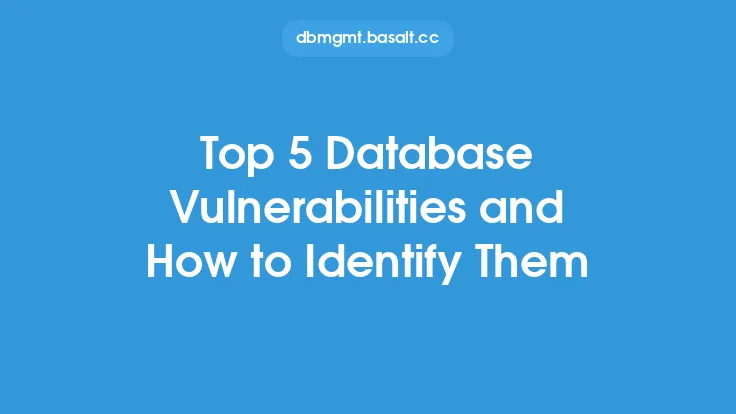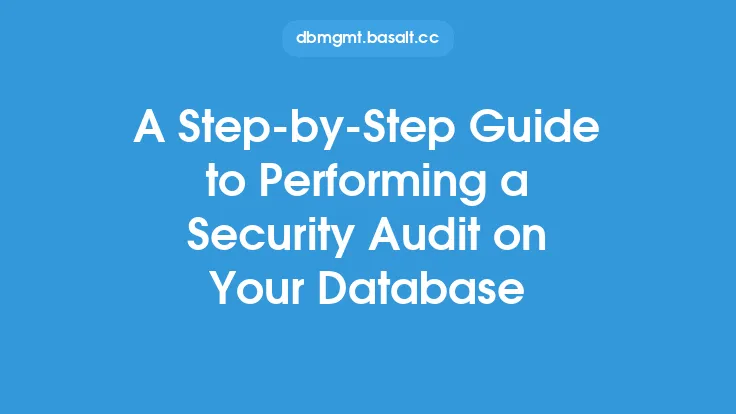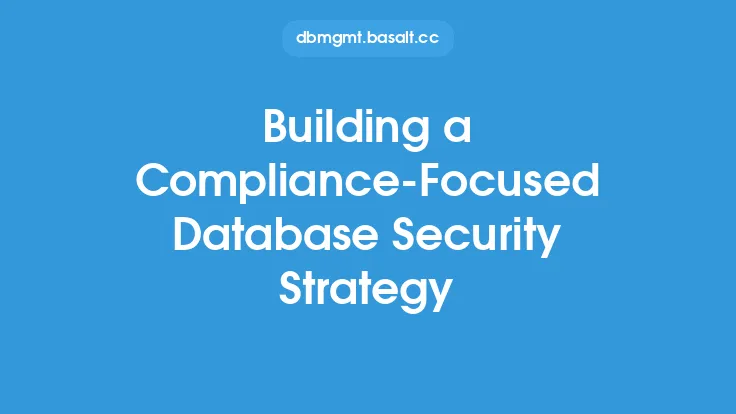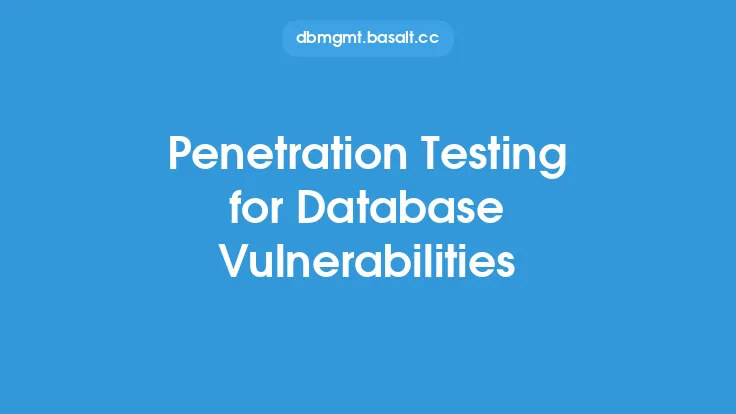Database security is a critical aspect of protecting sensitive information, and one of the most significant threats to database security is vulnerabilities. Two of the most common database vulnerabilities are SQL injection and cross-site scripting (XSS). These vulnerabilities can be exploited by attackers to gain unauthorized access to sensitive data, disrupt database operations, and even take control of the entire system. In this article, we will delve into the details of SQL injection and XSS, exploring what they are, how they occur, and most importantly, how to prevent and mitigate them.
Introduction to SQL Injection
SQL injection is a type of database vulnerability that occurs when an attacker is able to inject malicious SQL code into a web application's database in order to extract or modify sensitive data. This can happen when user input is not properly validated or sanitized, allowing an attacker to inject malicious code into the database. SQL injection attacks can be used to extract sensitive data, such as passwords or credit card numbers, or to modify data, such as changing user permissions or deleting data. There are several types of SQL injection attacks, including classic SQL injection, blind SQL injection, and time-based SQL injection. Classic SQL injection occurs when an attacker is able to inject malicious code into a database and receive immediate feedback. Blind SQL injection occurs when an attacker is not able to receive immediate feedback, but is still able to inject malicious code. Time-based SQL injection occurs when an attacker is able to inject malicious code and receive feedback based on the time it takes for the database to respond.
Introduction to Cross-Site Scripting (XSS)
Cross-site scripting (XSS) is a type of database vulnerability that occurs when an attacker is able to inject malicious code into a web application, which is then executed by the user's browser. This can happen when user input is not properly validated or sanitized, allowing an attacker to inject malicious code into the web application. XSS attacks can be used to steal sensitive data, such as session cookies or passwords, or to take control of the user's browser. There are several types of XSS attacks, including stored XSS, reflected XSS, and DOM-based XSS. Stored XSS occurs when an attacker is able to inject malicious code into a web application's database, which is then executed by the user's browser. Reflected XSS occurs when an attacker is able to inject malicious code into a web application, which is then reflected back to the user's browser. DOM-based XSS occurs when an attacker is able to inject malicious code into a web application's Document Object Model (DOM), which is then executed by the user's browser.
Causes of SQL Injection and XSS
SQL injection and XSS are caused by a combination of factors, including poor coding practices, inadequate input validation, and insufficient security measures. Poor coding practices, such as using outdated or insecure coding techniques, can make it easier for attackers to inject malicious code into a database or web application. Inadequate input validation can allow attackers to inject malicious code into a database or web application, while insufficient security measures can make it difficult to detect and prevent SQL injection and XSS attacks. Some common causes of SQL injection and XSS include using user input directly in SQL queries or web application code, failing to validate or sanitize user input, and using outdated or insecure coding techniques.
Prevention and Mitigation of SQL Injection and XSS
Preventing and mitigating SQL injection and XSS requires a combination of security measures, including input validation, output encoding, and secure coding practices. Input validation involves checking user input to ensure it is valid and does not contain malicious code. Output encoding involves encoding user input to prevent it from being executed by the database or web application. Secure coding practices, such as using prepared statements and parameterized queries, can help prevent SQL injection attacks. Regular security audits and penetration testing can also help identify and remediate SQL injection and XSS vulnerabilities. Additionally, using web application firewalls (WAFs) and intrusion detection systems (IDS) can help detect and prevent SQL injection and XSS attacks.
Best Practices for Secure Coding
Secure coding practices are essential for preventing SQL injection and XSS attacks. Some best practices for secure coding include using prepared statements and parameterized queries, validating and sanitizing user input, and encoding output. Prepared statements and parameterized queries can help prevent SQL injection attacks by separating code from data. Validating and sanitizing user input can help prevent XSS attacks by ensuring user input is valid and does not contain malicious code. Encoding output can help prevent XSS attacks by preventing user input from being executed by the browser. Additionally, using secure coding techniques, such as using HTTPS and validating user input on the server-side, can help prevent SQL injection and XSS attacks.
Tools and Technologies for Preventing SQL Injection and XSS
There are several tools and technologies available for preventing SQL injection and XSS attacks. Some of these tools and technologies include web application firewalls (WAFs), intrusion detection systems (IDS), and secure coding frameworks. WAFs can help detect and prevent SQL injection and XSS attacks by analyzing incoming traffic and blocking malicious requests. IDS can help detect and prevent SQL injection and XSS attacks by analyzing network traffic and identifying suspicious activity. Secure coding frameworks, such as OWASP ESAPI, can help prevent SQL injection and XSS attacks by providing a set of secure coding guidelines and APIs. Additionally, using security information and event management (SIEM) systems can help detect and respond to SQL injection and XSS attacks.
Conclusion
SQL injection and XSS are two of the most common database vulnerabilities, and can be exploited by attackers to gain unauthorized access to sensitive data, disrupt database operations, and even take control of the entire system. Preventing and mitigating these vulnerabilities requires a combination of security measures, including input validation, output encoding, and secure coding practices. By following best practices for secure coding, using tools and technologies for preventing SQL injection and XSS, and regularly conducting security audits and penetration testing, organizations can help protect their databases and web applications from these types of attacks.





